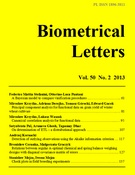
Biometrical Letters Vol. 50(2), 2013, pp. 107-116


Economic threshold level (ETL) is an important component in pest management and control. Usually, it is determined by the grower/technologist utilizing his experience on a crop; however, for cereals the values of these indices are available. Knowledge of ETL helps reduce crop loss (and ensure less pesticide application), and as a consequence, profit is increased. Also substantial knowledge is required on the dynamics of the pest population, in order to determine the density at which the economic injury level (EIL) may be prevented (Weersink et al. 1991). This paper is devoted to the development of an analytical method (probabilistic) for determination of ETL, which is defined as the density at which control measures should be determined to prevent an increasing pest population from reaching the economic injury level. A method to model the dynamics of the pest population is also proposed. The above method is demonstrated on a real life data set on pest (whitefly) incidence on betelvine, obtained from an experiment designed for that purpose.

Economic Threshold Level (ETL), Nonparametric and semi-parametric models, Occurrence Probability, Kolmogorov-Smirnov (K-S) Test

